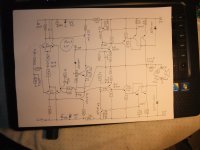Can you post photos?Currently I have an power amp device on the desk with output power devices in a TO-3 outline.
Unfortunately the surface is sanded, so that I haven't any possibility to read the type resp. model.
I will naturally go towards 15003,15023,21193 in TO3
Well low gain, bandwidth is low, secondary breakdown isn't great, and probably soon obsolete if not already I fear. Of the two the BUV22G has flatter gain against current, the 21 is significantly non-linear in this regard, and they don't have complementary parts. They are expressly designed for switch-mode operation.
Often used in the Naim clones (with limited voltage), although most builders these days have Gotten With The Program and switched to Sanken LAPTs(but still build it all NPN). Occasionally you still see someone pining away for 2N5038’s or BDY58 (even higher fT) but it’s going away. BUV21/22 are recommended for the TO-3 boards these days. Some just build with MJ15003 and it works, but it gets away from the original intent.
They may be on the chopping block and we’ll probably see them go EOL/MOQ, which will put them out of reach for casual DIY. If they didn’t have significant traction in industry for NON audio use, they would be gone gone gone already. You may be able to get them from outfits like Microsemi forever, but if you thought twenty bucks a pop was bad you’re in for some sticker shock.
They may be on the chopping block and we’ll probably see them go EOL/MOQ, which will put them out of reach for casual DIY. If they didn’t have significant traction in industry for NON audio use, they would be gone gone gone already. You may be able to get them from outfits like Microsemi forever, but if you thought twenty bucks a pop was bad you’re in for some sticker shock.
The Sziklai doesn’t preclude using 3-5 MHz outputs - the latest one I built used TIP35/6. The drivers are very important. What does your amp use for drivers? With modern sustained-beta types regular ON outputs work fine. The 21193/4 is the best match to the faster flatter Jap outputs. Slower yes, but at least the gain is flat up to around 5-8 amps before it tanks. And what supply voltage?The output buffer is executed as compound (Sziklai-) darlington.
From this point of view, the ST version with a higher value for Ft would be the better choice.
Unfortunately I don't know currently available successors for this obsolete type.
Is there a possibility to find out, what type is in use through certainly measurements by a transistor tester ?
as a general consideration in order to design an amplifier for audio as new project this is right.
But this consideration could be wrong (in order to get a stable operation without unwanted oscillation) if the output power devices are unknown.
If transistors with a ft of 20-50MHz were used in the original design and are replaced by ones with a ft of 2-5MHz, this can lead to unwanted oscillation under certain circumstances (of course depending on the circuit topology).
The statement that everything is uncritical on power amps for audible frequencies below 20-22KHz (which many engineers still believe today) is completely wrong and has already produced many a transistor graveyard regarding expensive power output devices.
The output buffer consist of three stages (triplet, last stage two pairs in parallel mode - go to the attached circuit diagram).
2N5550/2N5400 - 2SA968/2SC2238 - two pairs in TO-3 outline and in parallel mode and abraded type designation.
But this consideration could be wrong (in order to get a stable operation without unwanted oscillation) if the output power devices are unknown.
If transistors with a ft of 20-50MHz were used in the original design and are replaced by ones with a ft of 2-5MHz, this can lead to unwanted oscillation under certain circumstances (of course depending on the circuit topology).
The statement that everything is uncritical on power amps for audible frequencies below 20-22KHz (which many engineers still believe today) is completely wrong and has already produced many a transistor graveyard regarding expensive power output devices.
The output buffer consist of three stages (triplet, last stage two pairs in parallel mode - go to the attached circuit diagram).
2N5550/2N5400 - 2SA968/2SC2238 - two pairs in TO-3 outline and in parallel mode and abraded type designation.
Attachments
Last edited:
Oh no, not just a sziklai - an output stage with GAIN! Going to be finicky. To make these work, the drivers (the TO-5’s) need to be VERY fast with low output capacitance. Putting in bigger ones there to deal with lower speed outputs often doesn’t work at all.
When I see these circuits I just want to hit someone. If it was an EF or run of the mill unity gain Sziklai I wouldn’t be worried about it not working at all, and I would say they are non critical. Not here at all , unfortunately. I would be looking for ways to get TO3-P’s in there, and considering LAPTs. And even then youll probably still fight stability to some degree.
When I see these circuits I just want to hit someone. If it was an EF or run of the mill unity gain Sziklai I wouldn’t be worried about it not working at all, and I would say they are non critical. Not here at all , unfortunately. I would be looking for ways to get TO3-P’s in there, and considering LAPTs. And even then youll probably still fight stability to some degree.
- Home
- Amplifiers
- Solid State
- bipolar (BJT) transistor families for audio power output stages
